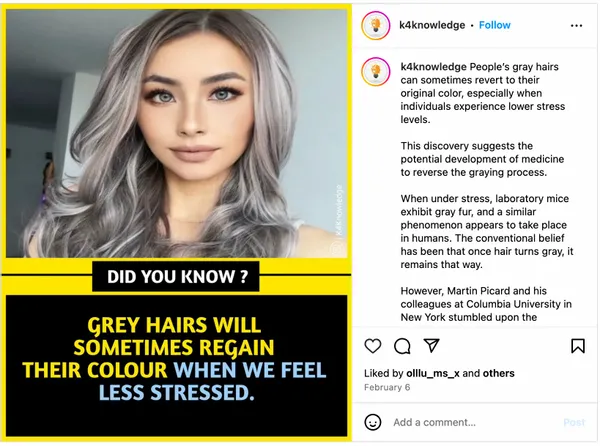In a world where fiction often blurs with reality, the notion of hair turning suddenly gray due to stress or a frightful experience has captured the imagination of many. Stories abound of characters whose locks have transformed overnight in response to a traumatic encounter. These narratives echo a curious phenomenon that has fascinated storytellers, scientists and hairstylists alike.
From comic-book characters like to the chilling transformation of following his harrowing torment at the behest of Vlad the Impaler in “Bram Stoker’s Dracula,” examples from film and literature illustrate the enduring fascination with this mysterious graying occurrence.
Wish-fulfillment regarding gray hair reverting back to its natural state has even been discussed on social media, with posts on X (formerly Twitter) like this one from , making the claim that “gray hairs can naturally regain their color when we feel less stressed,” or the following Instagram post:

(/Instagram)
Indeed, gray hair has long been considered an inevitable part of aging, attributed to the decline in pigment-producing cells within the hair follicle known as . The explained in a study that used mice to explore graying hair as it relates to stress, “New melanocytes are made from melanocyte stem cells that live within the hair follicle at the base of the hair strand. As we age, these stem cells gradually disappear. The hair that regrows from hair follicles that have lost melanocyte stem cells has less pigment and appears gray.”
However, a recent study titled “Quantitative mapping of human hair greying and reversal in relation to life stress,” conducted by researchers at , challenged this notion by exploring the potential role of psychological stress in the reversal of gray hair.
Researchers at Columbia University’s Vagelos College of Physicians and Surgeons published their findings in in 2021, after analyzing the tresses of 14 volunteers. The results suggested a potential link between stress and the reversal of gray hair to its natural color. While this study provided insights into the relationship between stress and hair pigmentation, it’s important to note the phenomenon seems to have limitations and may not apply universally.
The study, led by , associate professor of behavioral medicine, used a novel method to analyze pigmentation patterns along individual hair shafts, allowing researchers to quantify the extent of graying in response to stress. The study notes:
Ayelet Rosenberg, first author on the study and a student in Picard’s laboratory, developed a new method for capturing highly detailed images of tiny slices of human hairs to quantify the extent of pigment loss (graying) in each of those slices. Each slice, about 1/20th of a millimeter wide, represents about an hour of hair growth.
“If you use your eyes to look at a hair, it will seem like it’s the same color throughout unless there is a major transition,” Picard says. “Under a high-resolution scanner, you see small, subtle variations in color, and that’s what we’re measuring.”
By capturing detailed images of hair slices, the researchers were able to correlate stress levels with changes in hair pigmentation.
The study revealed instances where gray hairs appeared to regain their original color when stress was reduced, a phenomenon that contradicts the prevailing belief that gray hair is irreversible. However, it’s important to note that not all gray hairs responded to stress reduction, suggesting that the phenomenon may be limited to certain individuals or circumstances.
“There was one individual who went on vacation, and five hairs on that person’s head reverted back to dark during the vacation, synchronized in time,” Picard said.
Emphasizing the significance of the findings, Picard noted, “Understanding the mechanisms that allow ‘old’ gray hairs to return to their ‘young’ pigmented states could yield new clues about the malleability of human aging in general and how it is influenced by stress.”
Further analysis of protein levels in the hair follicles provided insights into the potential mechanism linking stress to hair turning gray.
“Mitochondria are actually like little antennas inside the cell that respond to a number of different signals, including psychological stress,” Picard explained to Columbia University’s Irvine Medical Center. Changes in mitochondrial activity, influenced by stress, were implicated in the loss and potential restoration of hair pigmentation.
The association between mitochondria and stress-related changes in hair color differs from findings in the study involving mice. In that study, researchers discovered that stress-induced graying resulted from an within the hair.
“Our data show that graying is reversible in people, which implicates a different mechanism,” said Dr. Ralf Paus, professor of dermatology at the University of Miami Miller School of Medicine and a contributor to the Columbia University study. “Mice have very different hair follicle biology, and this may be an instance where findings in mice don’t translate well to people.”
While the Columbia University study offered intriguing insights into the relationship between stress and hair pigmentation, it’s important to recognize that the process is not fully understood and may not apply to everyone. Factors such as genetics, age and overall health may influence the likelihood of hair re-pigmentation in response to stress reduction.
The study noted the evidence of a potential “threshold-based mechanism” for short-lived graying — if hairs are about to go gray due to the aging process and genetics, a personal upheaval may be the stress that triggers the sudden change. And when the traumatic situation comes to an end or is eliminated, if a hair remains above that threshold, it could revert back to its original hue.
“Based on our mathematical modeling, we think hair needs to reach a threshold before it turns gray,” Picard said. “In middle age, when the hair is near that threshold because of biological age and other factors, stress will push it over the threshold and it transitions to gray.
“But we don’t think that reducing stress in a 70-year-old who’s been gray for years will darken their hair or increasing stress in a 10-year-old will be enough to tip their hair over the gray threshold.”
So, while stress reduction may have some benefits for maintaining natural hair color, it isn’t a guarantee for reversing gray hair for everyone. Further research is needed to make clearer the mechanisms involved and determine the factors that influence hair pigmentation changes.
